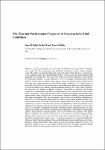The Thermal Performance Prospects of Courtyards in Cold Conditions
| dc.contributor.author | Al-Hafith, O | |
| dc.contributor.author | B.K., S | |
| dc.contributor.author | de Wilde, P | |
| dc.date.accessioned | 2024-04-09T10:37:47Z | |
| dc.date.available | 2024-04-09T10:37:47Z | |
| dc.date.issued | 2022 | |
| dc.identifier.uri | https://pearl.plymouth.ac.uk/handle/10026.1/22258 | |
| dc.description.abstract |
Aiming at developing more thermally comfortable and energy efficient buildings, some studies have been advocating using traditional architecture’s passive design strategies. Among the rarely investigated architectural elements to achieve this objective in cold climates is the courtyard space. This environmental element, in most cases, has been examined and suggested for hot conditions. However, some studies have shown indications of its potential environmental efficiency in cold conditions as well. In principle, courtyards enable having sheltered outdoor spaces to regulate indoor spaces’ interaction with the outdoor climate instead of having them outward oriented to directly face outdoor conditions. This research aims to determine whether this thermal performance of courtyards can be positive in cold conditions as it is in hot conditions, for instance, through protecting buildings from cold winds. To achieve this objective, the research conducted simulation experiments to determine the thermal conditions of 360 different courtyards and compared them with a typical modern urban outdoor space’s conditions. If the courtyard space offers a warmer environment than modern urban outdoor spaces, then it might lead to a wider positive impact on buildings’ thermal conditions and energy consumption. The used simulation tool to conduct the simulation experiments is Envi-met 4.2, which has been widely used and validated by previous simulation studies. The tested courtyard forms are of different geometric configurations to show a wide range of possible conditions in courtyards. The simulation was done for Baghdad, in which courtyards have been widely used for centuries. This city has a hot summer, but its winter temperature is between 0°C and 12°C. The Globe Temperature was used to determine peoples’ thermal sensation. Its value includes the impact of air velocity, radiation and air temperature, which makes it representing people’s actual thermal sensation properly. The results showed that courtyards offer higher Globe Temperature than modern urban spaces in cold conditions, mainly, through protecting buildings and occupants from winds. The air velocity inside courtyards can be one-tenth of air velocity in a modern urban outdoor space. The geometric properties of courtyards significantly affect courtyards’ thermal conditions. These results indicate that the courtyard space can be more thermally efficient than modern urban spaces even in cold climate conditions. However, its geometric properties need to be properly considered to have its highest possible thermal efficiency. Otherwise, the courtyard might lose its efficient thermal performance. | |
| dc.title | The Thermal Performance Prospects of Courtyards in Cold Conditions | |
| dc.type | conference | |
| plymouth.conference-name | International Conference on Architecture & Interior Design (ICAD2021) | |
| plymouth.organisational-group | |Plymouth | |
| plymouth.organisational-group | |Plymouth|Faculty of Arts, Humanities and Business | |
| plymouth.organisational-group | |Plymouth|Faculty of Arts, Humanities and Business|School of Art, Design and Architecture | |
| plymouth.organisational-group | |Plymouth|REF 2021 Researchers by UoA | |
| plymouth.organisational-group | |Plymouth|Users by role | |
| plymouth.organisational-group | |Plymouth|Users by role|Current Academic staff | |
| plymouth.organisational-group | |Plymouth|REF 2021 Researchers by UoA|UoA13 Architecture, Built Environment and Planning | |
| plymouth.organisational-group | |Plymouth|REF 2029 Researchers by UoA | |
| plymouth.organisational-group | |Plymouth|REF 2029 Researchers by UoA|UoA13 Architecture, Built Environment and Planning | |
| dcterms.dateAccepted | 2021-11-01 | |
| dc.date.updated | 2024-04-09T10:37:46Z | |
| dc.rights.embargodate | 2024-4-11 |


